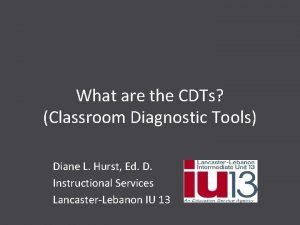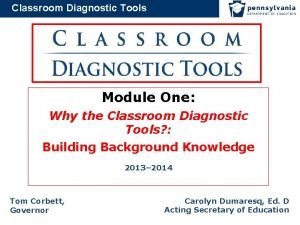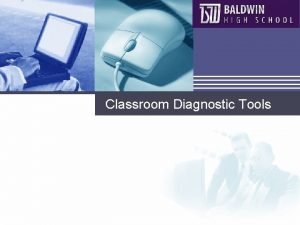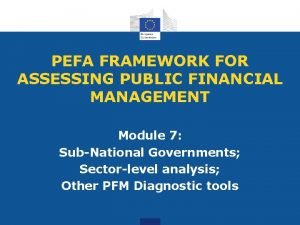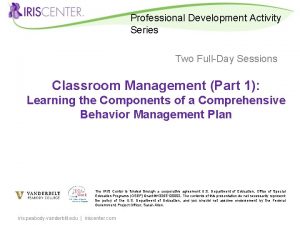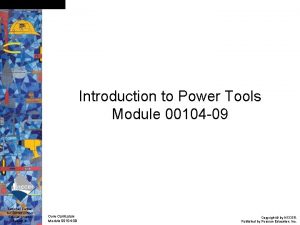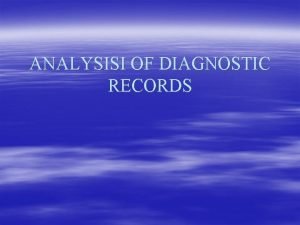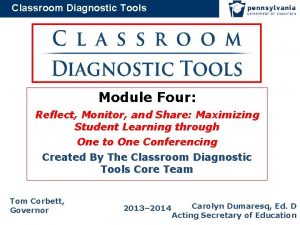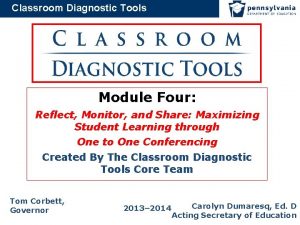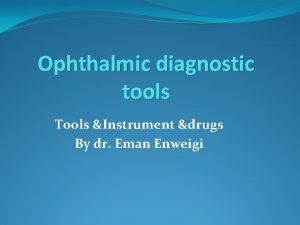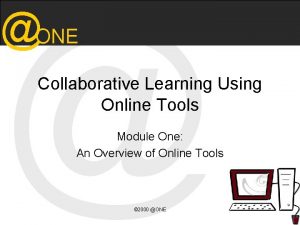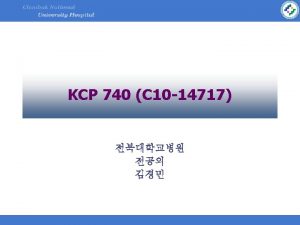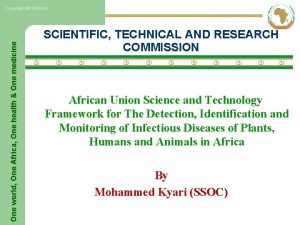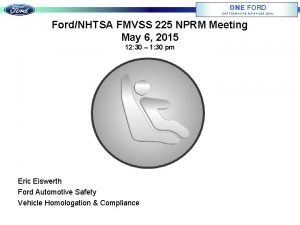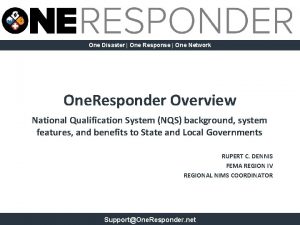Classroom Diagnostic Tools Module One Why the Classroom




















- Slides: 20

Classroom Diagnostic Tools Module One: Why the Classroom Diagnostic Tools? : Building Background Knowledge 2013– 2014 Tom Corbett, Governor Carolyn Dumaresq, Ed. D Acting Secretary of Education

Classroom Diagnostic Tools What’s in this Module? • CDT Connection to the Standards-Aligned System (SAS) • Why we use the Diagnostic tool • Features of the diagnostic reports • CDT Content Areas and Sample Map • Identification of CDT Target Groups 2

Classroom Diagnostic Tools What are the Classroom Diagnostic Tools? The Pennsylvania Classroom Diagnostic Tools (CDT) are a set of online tools designed to provide diagnostic information in order to guide instruction and provide support to students and teachers. These tools (available at no cost to districts) are fully integrated and aligned with the Standards Aligned System (SAS) and will assist educators in identifying students’ academic strengths and areas of need, providing links to classroom resources. 3

Classroom Diagnostic Tools What are the Classroom Diagnostic Tools? The CDT is: • • • Offered to students in grades 6 through high school. (Field test down to grade 3 in fall of 2013 and operational in spring of 2014. ) Available for use in the classroom throughout the school year on a voluntary basis 3 -5 times per year. Based on content assessed by the Keystone Exams and the Pennsylvania System of School Assessment (PSSA). Composed of multiple-choice items. Delivered as an online Computer Adaptive Test (CAT), ensuring valid and reliable measures of a student’s skills while minimizing testing time. Designed to provide real-time results for students and teachers with links to Materials and Resources in SAS. 4

Classroom Diagnostic Tools Why should the Classroom Diagnostic Tools be used? Benefits for Students: • • • Provides specific and timely feedback designed to support student learning Builds efficacy by bringing students into the process of their own learning Promotes goal setting by involving students in the learning process Provides students with opportunities to demonstrate their knowledge and skills Promotes partnering with educators (e. g. , one-to-one conferencing) Ensures that follow-up instruction is meaningful and aligns with student learning expectations 5

Classroom Diagnostic Tools CDT Content Areas • Math – Math Grades 6, 7, 8, Algebra II, Geometry • Literacy – Reading Grades 6, 7, 8, Literature – Writing Grades 6, 7, 8, Composition • Science – Science Grades 6, 7, 8, High School – Biology, Chemistry 6

Classroom Diagnostic Tools How often should the Classroom Diagnostic Tools be administered? Information about student strengths and areas of need over time enables educators to plan student instruction and provide appropriate follow-up activities to meet ongoing learning expectations. The CDT could be administered to students three to five times per school year based on student needs and analysis of data. • The maximum number of administrations is five per CDT per school year. • The recommended time between each administration is 5– 6 weeks. 7

Classroom Diagnostic Tools Each of the statements below is a characteristic of a Benchmark assessment (think 4 Sight or Study Island), a Diagnostic assessment (specifically the CDT) or both. Circle the appropriate answer. DESCRIPTOR: Benchmark Diagnostic Both Results inform instructional practice Grade/course-level specific Benchmark Diagnostic Both Benchmark Diagnostic Both Administered throughout the school year Benchmark Diagnostic Both Gives information in regards to mastery of grade-level standards Benchmark Diagnostic Both Gives immediate results of student performance Benchmark Diagnostic Both Suggests instructional strategies that will help individual students Benchmark Diagnostic Both Answers the question “what”. What standards have the students achieved? What standards have not yet been met? Benchmark Diagnostic Both Answers the questions “what, ” “why, ” and “how”. What standards have the students achieved? How learning within a diagnostic category, based upon the Assessment Anchors and Eligible Content develops across grades. Why a student is achieving by breaking benchmarks across the learning progressions into fundamental skills and analyzing patterns of achievement across multiple measures. Predicts success on the PSSA Benchmark Diagnostic Both Can be given up to (but not more than) 5 times per year Benchmark Diagnostic Both Results give a proficiency level Benchmark Diagnostic Both Students may be tested on material not formerly taught Benchmark Diagnostic Both A no cost assessment for PA LEAs Benchmark Diagnostic Both Supports differentiated instruction within Rt. II Tiers 1, 2, and 3 Benchmark Diagnostic Both Are quarterly formative assessments for grades 3 to 8. These assessments were created specifically to mirror the content and look of the PSSA. They are intended to provide a quick estimate of how students would perform on the PSSA if the state test were administered on the same day Benchmark Diagnostic Both 8

Classroom Diagnostic Tools What are the similarities and differences between Benchmark Assessments and Diagnostic Tools? Diagnost Benchmark ic Grade-level specific Results support goal setting Measures content at the reporting category level for reading and math Provides a standards-aligned benchmark Results need to be used Share with parents Students do not receive direct, formative feedback Informs instructional process Answers the question, What? Diagnosis of student strengths and areas of need at instructional level Answers the questions, What? Why? and How? Can be given no more than five times a year Provide effective feedback Provides current level of performance Forces us to ask more questions Process of regularly collecting, summarizing, and analyzing information to guide development, implementation, and evaluation of instruction Class tool Identifies areas of strengths and needs across grade levels and subject areas Individual/small group measurement tool Most lessons to support eligible content for strengths and areas of need are available on SAS Students may be tested on material not formerly taught Provides an estimate of student performance on a summative assessment Results may be used to establish student goal setting Fixed form–everyone takes the same assessment at a given grade level Group measurement Administered throughout the school year Summary report Computer-adaptive tool based on a vertical scale that spans content from grades 3 to high school/course Supports differentiated instruction within Rt. II Tiers 1, 2 and 3. 9

Classroom Diagnostic Tools CDT Assessment Cycle 10

Classroom Diagnostic Tools Reports and What they Mean? *Reports provide a snapshot of how students are performing in relation to the Pennsylvania Assessment Anchors & Eligible Content and Keystone Assessment Anchors & Eligible Content. *The diagnostic reports link to targeted curricular resources and materials, including units and lesson plans found within the SAS system. 11

Classroom Diagnostic Tools How are Scale Scores Derived? • • • Students’ scores are converted into scale scores rather than points correct or raw scores Scale scores are transformed raw scores that allow for valid comparisons across students, grades, and administrations, but only within the same subject Scales scores take into consideration the fact that some questions on the test are more difficult than others CDT Minimum scale score of 400 CDT Maximum scale score of 2000 Note: Item Response Theory (IRT), specifically the Rasch model, is used to determine the student’s raw score 12

Classroom Diagnostic Tools Red= Areas of Need Green/Blue=Student Strengths to Build 13

Classroom Diagnostic Tools Defining the Tabs Group Map- Illustrates the entire class results. Each student is represented by a white dot. Individual Map- Shows a specific student’s results on the assessment. Individual/Group Learning Progression Map- Breaks down the specific eligible content that students demonstrate equal to or better than expected performance, or performance on Eligible Content that was less than expected performance. 14

Classroom Diagnostic Tools Group Diagnostic Map – Algebra I 12/7/2020 15

Classroom Diagnostic Tools Group Diagnostic Map – Mathematics Zoomed In 12/7/2020 Zoomed Out 16

Classroom Diagnostic Tools Group Diagnostic Map Single Diagnostic Category 12/7/2020 17

Classroom Diagnostic Tools Learning Progressions • What are Learning Progressions? – Learning Progressions show the developmental sequences or building blocks of content/skills students need to master as they progress toward career and college readiness. – The progressions are tied directly to the Assessment Anchors and Eligible Content. – The progressions are also tied directly to the Voluntary Model Curriculum (VMC) Units and Lesson Plans and are posted on the SAS Website. 12/7/2020 18

Classroom Diagnostic Tools CDT Learning Progression Map • The CDT includes a report tied directly to Learning Progressions. • This report: – provides a scrollable vertical map showing how a student’s learning progresses for each diagnostic category across grades and/or courses. – helps teachers plan targeted instruction by providing a visual snapshot of how the student is progressing. – includes information as to whether the student is • still struggling to master foundational content and/or • moving forward with more advanced content. 12/7/2020 19

Classroom Diagnostic Tools CDT Learning Progression Map • This report also – shows exactly which Assessment Anchors and Eligible Content is measured by each CDT item or items the student answered correctly or incorrectly. – provides a sample item of average difficulty for each Assessment Anchor as defined by the Eligible Content. – provides teachers with the most efficient and direct way to find units and lesson plans in SAS directly tied to Eligible Content. – links directly to additional materials and resources in SAS. 12/7/2020 20
 Classroom diagnostic tools
Classroom diagnostic tools Classroom diagnostic tools score ranges
Classroom diagnostic tools score ranges Classroom diagnostic tools scoring
Classroom diagnostic tools scoring Hey bye bye
Hey bye bye Diagnostic tool loopback adapter
Diagnostic tool loopback adapter Diagnostic tools for pfm
Diagnostic tools for pfm Dont ask
Dont ask C device module module 1
C device module module 1 Iris module classroom management
Iris module classroom management One god one empire one emperor
One god one empire one emperor Little dog run
Little dog run One king one law one faith
One king one law one faith One empire one god one emperor
One empire one god one emperor One ford behaviors
One ford behaviors See one do one teach one
See one do one teach one One price policy
One price policy Night structure
Night structure Studiendekanat uni bonn
Studiendekanat uni bonn One vision one identity one community
One vision one identity one community Asean one vision one identity one community
Asean one vision one identity one community Introduction to power tools module 4
Introduction to power tools module 4
